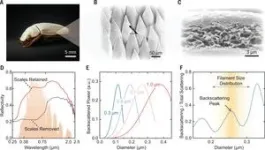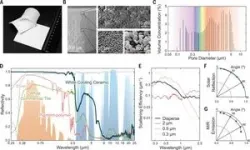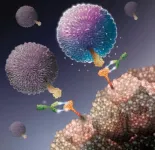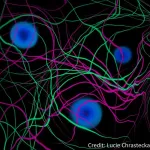(Press-News.org) As cities grow bigger and faster, water pollution is becoming a serious problem. We need good ways to clean the water. Traditional cleaning methods, Persulfate (PS)- Advanced Oxidation Processes (AOPs), are good at treating the bad stuff in the water, but they require a lot of energy and chemicals, like special light and metals ions. This is costly and environmentally harmful. It's urgent to find better and more eco-friendly ways to clean it.
In a recent study published in Volume 18 of the journal Environmental Science and Ecotechnology, scientists from Jinan University discuss a new, eco-friendly way to clean water. They've discovered a method called "piezoelectric activation of PS." This technique uses special materials that create piezoelectricity when they are squeezed or pressed, thereby cleaning the water. What's really cool is that this squeezing can come from natural things like wind, ocean waves, or river currents. So, it doesn't need extra energy, making it a very green and efficient way to make water safe.
The research on piezoelectric/PS-AOPs is about finding new ways to clean water using a special process. This process uses materials that can generate the piezoelectricity when they are pressed or squeezed. This piezoelectricity is then used to activate a chemical called persulfate, which helps break down harmful substances in the water. Scientists are working with different materials like BaTiO₃, ZnO, and MoS₂ to make this process better. They face challenges like not getting enough energy from the materials and slow movement of electrons, but they're improving the materials to solve these problems. They're also exploring using natural forces like wind and water flow to power this process, which is a sustainable and eco-friendly approach. This new technology could do more than just clean water; it could also turn the bad substances in the water into useful things. This makes it a really promising way to clean water in environmental remediation. As research goes on, this method could become a major way to treat water and control pollution, using renewable energy and being kind to the environment. Dr. Mingshan Zhu, a leading researcher in the field, emphasized the significance of this development: "Piezoelectric activation of persulfate represents a paradigm shift in water treatment technology. It not only addresses the efficiency and environmental concerns associated with traditional methods but also opens up new pathways for using renewable energy sources."
This exciting method is transforming the way we purify water. It's environmentally friendly, energy-efficient, and highly effective at combating water pollution. Representing a significant leap towards a cleaner and healthier planet, this technique doesn't just enhance water cleanliness; it plays a substantial role in environmental protection. It's a comprehensive approach to making our world a better place.
###
References
DOI
10.1016/j.ese.2023.100329
Original Source URL
https://doi.org/10.1016/j.ese.2023.100329
Funding information
The National Science Foundation of China (22322604 and 22006052); The Guangdong Basic and Applied Basic Research Foundation (2020B1515020038); The Pearl River Talent Recruitment Program of Guangdong Province (2019QN01L148).
About Environmental Science and Ecotechnology
Environmental Science and Ecotechnology (ISSN 2666-4984) is an international, peer-reviewed, and open-access journal published by Elsevier. The journal publishes significant views and research across the full spectrum of ecology and environmental sciences, such as climate change, sustainability, biodiversity conservation, environment & health, green catalysis/processing for pollution control, and AI-driven environmental engineering. The latest impact factor of ESE is 12.6, according to the Journal Citation ReportTM 2022.
END
Unlocking sustainable water treatment: the potential of piezoelectric-activated persulfate
2024-01-03
ELSE PRESS RELEASES FROM THIS DATE:
On-demand conformation of an artificial cytoskeleton
2024-01-03
Peptide nanotubes are tubular-shaped structures formed by the controlled stacking of cyclic peptide components. These hollow biomaterials show inner and outer faces, allowing the control over their properties.
Led by Juan R. Granja, researchers from the Center for Research in Biological Chemistry and Molecular Materials (CiQUS) presented a novel kind of cyclic peptide that, when light-irradiated, induces the formation or desegregation of nanotubes on demand. At the appropriate wavelength, the peptide switches from a folded to a flat conformation. When the planar conformation is ...
Can artificial intelligence (AI) improve musculoskeletal imaging?
2024-01-03
(Boston)—While musculoskeletal imaging volumes are increasing, there is a relative shortage of subspecialized musculoskeletal radiologists to interpret the studies. Is AI the solution?
“With the ongoing trend of increased imaging rates and decreased acquisition times, a variety of AI tools can support musculoskeletal radiologists by providing more optimized and efficient workflows,” says corresponding author Ali Guermazi, MD, PhD, chief of radiology at VA Boston Healthcare System and professor of radiology and medicine at Boston University Chobanian & Avedisian School of Medicine.
In a new article in the journal Radiology, BU researchers provide ...
Case Western Reserve researchers land $1.125 million National Science Foundation grant to advance safer, faster and less expensive medical-imaging technology
2024-01-03
CLEVELAND—Diagnosing cancer today involves using chemical “contrast agents” to improve the accuracy of medical imaging processes such as X-rays as well as computed tomography (CT) and magnetic resonance imaging (MRI) scans.
But those agents can be expensive, take more time to use and pose potential health concerns.
With a new four-year, $1.125 million grant from the National Science Foundation (NSF), researchers at Case Western Reserve University hope to develop an artificial intelligence (AI) alternative ...
PTSD: the brain basis of susceptibility - a free webinar from the Brain & Behavior Research Foundation
2024-01-03
The Brain & Behavior Research Foundation (BBRF) is hosting a free webinar, “PTSD: The Brain Basis of Susceptibility” on Tuesday, January 9, 2024, at 2:00 pm ET. The presenter will be Nathaniel G. Harnett, Ph.D., Director of the NATE Lab at McLean Hospital and Assistant Professor in Psychiatry at Harvard Medical School. Dr. Harnett is also the recipient of a 2021 Young Investigator Grant. The webinar will be hosted by Jeffrey Borenstein, M.D., President & CEO of the Brain & Behavior Research Foundation, and host of the public television series Healthy Minds.
Register today ...
Knowing how clinicians make real-world decisions about drug-drug interactions can improve patient safety
2024-01-03
INDIANAPOLIS — Drug-drug interactions causing adverse effects are common and can cause significant patient harm and even death. A new study is one of the first to examine how clinicians become aware of and process information about potential interactions and subsequently make their real-world decisions about prescribing. Based on these findings, the research team makes specific recommendations to aid clinician decision-making to improve patient safety.
“Drug-drug interactions are very common, more common than a lot of people outside the healthcare system expect. In the U.S., these interactions lead to hundreds of thousands of hospitalizations ...
Immune cell helps predict skin cancer patients’ chances of responding to treatment
2024-01-03
A type of immune cell can help predict which patients may benefit most from cancer immunotherapies, researchers from King’s College London, Guy’s and St Thomas’ Hospital Trust, and the Francis Crick Institute have found.
The study, published today in Nature Cancer, found that a rare type of T cells (a type of immune cell), can help predict the likelihood of whether a patient with advanced skin cancer will be responsive to immunotherapy treatments. The results could also lead to the development of new and more effective treatments for patients with melanoma who do not benefit from current ...
Reprogrammed fat cells support tumor growth
2024-01-03
Mutations of the tumor suppressor p53 not only have a growth-promoting effect on the cancer cells themselves, but also influence the cells in the tumor's microenvironment. Scientists at the German Cancer Research Center (DKFZ) and the Weizmann Institute in Israel have now shown that p53-mutated mouse breast cancer cells reprogram fat cells. The manipulated fat cells create an inflammatory microenvironment, impairing the immune response against the tumor and thus promoting cancer growth.
No other gene is mutated as frequently in human tumors as the gene for the tumor suppressor p53. In around 30 percent of all cases of breast cancer, the cancer cells show mutations or losses ...
Early primates likely lived in pairs
2024-01-03
Primates – and this includes humans – are thought of as highly social animals. Many species of monkeys and apes live in groups. Lemurs and other Strepsirrhines, often colloquially referred to as “wet-nosed” primates, in contrast, have long been believed to be solitary creatures, and it has often been suggested that other forms of social organization evolved later. Previous studies have therefore attempted to explain how and when pair-living evolved in primates.
More recent research, however, indicates that many nocturnal Strepsirrhines, which are more challenging to investigate, are not in fact solitary but live in pairs of males and females. But ...
Foundation laid for improved diagnostic imaging of brain tumors
2024-01-03
Research team draws up criteria for PET-based examinations of malignant brain tumors
Diffuse gliomas are malignant brain tumors that cannot be optimally examined by means of conventional MRI imaging. So-called amino acid PET scans are better able to image the activity and spread of gliomas. An international team of researchers (RANO Working Group), led by scientists from LMU and the Medical University of Vienna, has now drawn up the first ever international criteria for the standardized imaging of gliomas using amino acid PET. It has published its results ...
Magnetic fields in the Cosmos: dark matter could help us discover their origin
2024-01-03
The mini-halos of dark matter scattered throughout the Cosmos could function as highly sensitive probes of primordial magnetic fields. This is what emerges from a theoretical study conducted by SISSA and published in Physical Review Letters. Present on immense scales, magnetic fields are found everywhere in the Universe. However, their origin are still subjects of debate among scholars. An intriguing possibility is that magnetic fields originated near the birth of the universe itself, that is they are primordial magnetic fields. In the study, researchers showed that if magnetic fields are indeed primordial then it could cause an increase in dark matter density perturbations ...






